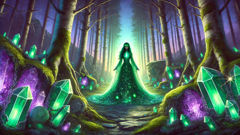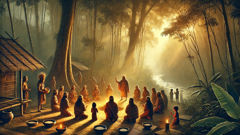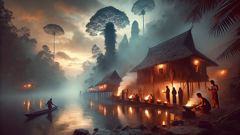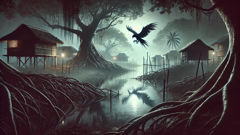Introduction
In the heart of Russia’s Ural Mountains, where the forests are thick with ancient pines and birches and the ground shimmers with veins of precious minerals, tales are as old as the stones themselves. Among these stories, none is whispered more often by firesides or sung more hauntingly by miners than the legend of the Stone Flower. This is a story woven from emerald, malachite, and copper—a tapestry of longing and creation. Here, men and women live and die by the earth’s bounty, carving out their fate as they carve the stone. The Ural region is a land of extremes: spring’s brief, riotous green; the icy silence of winter; and the perpetual mystery that lingers in its caves and mountain folds. It’s a place where belief in the unseen comes as naturally as breathing, and where the boundary between this world and another, more wondrous realm is often gossamer-thin. Generations have spoken of the Mistress of the Copper Mountain, a spirit as old as the rocks, guarding her domain with pride and severity. Some say she appears as a beautiful woman with green eyes and a crown of gems, her dress shifting with the colors of malachite and azurite. Others claim she is a stern force, bestowing fortune or misfortune with the flick of her slender fingers. It is said only the pure of heart and the masters of their craft may ever glimpse her secret, the legendary Stone Flower—a blossom carved from stone, so perfect that it seems to breathe, but impossible to recreate. This tale follows Danila, a humble but gifted craftsman, whose yearning for beauty sets him on a path that will test his courage, his artistry, and the limits of what it means to seek perfection.
Danila: The Stone Carver’s Dream
Danila was born in the small mining village of Sysert, nestled deep within the folds of the Ural Mountains. From the earliest days, he was drawn to stone—not just for its weight or color, but for the possibility he saw within it. Where others saw hard, unyielding rock, Danila saw shapes, patterns, and stories waiting to be coaxed forth. His hands, long-fingered and deft, could trace the veins of a malachite slab and imagine the play of light across a dragonfly’s wing or the curling petals of a woodland flower.
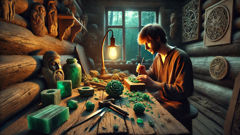
Danila’s mentor was Prokopych, a master stone carver respected for his patience and wisdom. Under Prokopych’s watchful eye, Danila learned the secrets of the chisel and the grinder, how to polish jade until it glowed, and how to let the stone’s own nature guide his design. But Danila’s ambitions ran deeper than his teacher knew. He was obsessed with the idea of creating something no one had ever seen: a flower carved from stone, so lifelike that it would seem to bloom beneath the touch. The villagers scoffed at the notion. Flowers belonged to the world above ground, they said, not to the cold embrace of mineral and darkness. But Danila believed otherwise. In his dreams, he saw petals spun from malachite and stems twined with copper, trembling with a beauty that was both natural and utterly otherworldly.
One evening, as the sun set in a blaze of gold behind the mountains, Danila wandered into the woods in search of inspiration. The forest felt alive—roots tangled beneath his feet, birds sang warnings in the branches, and a breeze shivered the ferns. He knelt beside a brook, letting his fingers run through the pebbles at its edge. One stone, a piece of green malachite veined with black, caught his eye. As he turned it over in his hand, a voice as clear as a bell echoed through the trees.
“Why do you trouble yourself with such dreams, Danila?”
Startled, Danila looked up to find a woman standing across the brook. She was tall, her hair dark as midnight, her eyes glinting green. She wore a dress that seemed spun from gems, every fold shimmering with hidden light. Danila knew at once who she was—the Mistress of the Copper Mountain.
He bowed low, heart hammering. “Mistress, I wish to carve a stone flower—a blossom that lives and breathes with beauty.”
She smiled, but there was sadness in her eyes. “Many have tried, Danila. None have succeeded. Perfection comes at a price. Are you ready to pay it?”
Danila hesitated. What could be worth such beauty? His family, his village, his very soul? Yet the longing in his heart outweighed every fear.
“I am,” he said quietly.
The Mistress beckoned. “Then follow. The path is not for the faint-hearted.”
The forest seemed to part for her as she led Danila deeper, through thickets of bramble and patches of wildflowers, until they reached a hillside carpeted in moss. There, hidden among the roots of an ancient pine, was a crevice that glowed with an emerald light. Without looking back, the Mistress slipped inside. Danila followed, the world narrowing to damp stone and the echo of his own breath.
Inside, the air hummed with magic. Crystals studded the walls, casting shifting patterns across his face. The Mistress moved effortlessly through the darkness, her presence guiding him onward. At last, they entered a vast chamber, where pillars of malachite rose like trees and veins of copper traced the ceiling like lightning. At the center of the chamber stood a pedestal. On it rested the Stone Flower—a blossom so perfect that Danila’s heart ached at the sight. Each petal was translucent, shot through with threads of gold and silver. It seemed to pulse with its own inner light, delicate yet eternal.
The Mistress’ voice was soft. “This is what you seek. But to create such a thing, you must understand the stone—not just its beauty, but its pain, its longing, its memory of earth and fire. Will you learn?”
Danila nodded, his resolve hardening.
The lessons began. Days and nights blended as Danila labored in the subterranean world. The Mistress taught him the song of stone, how each crystal grows with patience, how minerals remember the rivers that shaped them. He learned to listen—to the silence between hammer strikes, to the story in every fracture. Sometimes he despaired, feeling the distance grow between himself and his old life. He dreamt of his mother’s gentle hands, of Prokopych’s stern encouragement. Yet the vision of the Stone Flower drove him onward, through exhaustion and longing.
One evening, as Danila worked beneath a waterfall of shimmering quartz, he felt a shift within himself. His hands moved not just with skill, but with empathy—with reverence for the material and all it had endured. When he finished, he looked down at his work: a single petal, so fine it caught the light and glowed from within. The Mistress smiled, pride softening her features. “You are close, Danila. Only one task remains.”
She led him to a deep cavern, where a river ran beneath the earth. “You must choose: remain here, a master of stone and secrets, or return to your world—carrying what you have learned, but leaving the perfect flower behind.”
Danila hesitated. The choice was cruel. To stay would mean abandoning his family and village forever; to leave would mean surrendering his dream of perfection. After a long silence, he chose to return.
The Mistress pressed a small stone into his palm—a piece of malachite, warm and pulsing with hidden light. “Go. Remember what you have learned. Perfection is not in the object, but in the heart that strives for it.”
Danila awoke at dawn on the forest floor, the mist swirling around him. The malachite stone glowed in his hand. He knew what he had to do.
Descent into the Copper Mountain
Danila returned to Sysert changed—quieter, more focused, yet carrying a weight that no one else could see. He resumed work in Prokopych’s workshop, but something in his gaze had deepened. The other apprentices noticed how his hands seemed guided by invisible threads, how even simple carvings now held a life and clarity that outshone their own. Yet Danila was restless. The fragment of malachite from the Mistress was always with him, warm against his skin, a reminder that beauty was not just in form but in understanding.

He worked tirelessly, laboring through bitter winters and short, brilliant summers. Word of his artistry spread beyond Sysert; merchants came from Yekaterinburg and even Moscow to see his work. But Danila was never satisfied. He would sit for hours beside the river, sketching wildflowers—the blue starflowers, the purple irises, the snowdrops that carpeted the meadows each spring. Still, the perfect stone flower eluded him. He realized that what he sought could not be copied from nature, nor conjured by skill alone.
One evening, as thunder rolled over the mountains and rain battered the village, Danila’s resolve snapped. He told Prokopych he must leave. The old master saw the longing in his pupil’s eyes and did not protest. With only a satchel and his tools, Danila set out once again toward the heart of the mountains. The forest seemed wilder than before. Shadows crept between the trees, and the songbirds fell silent at his approach. He walked for days, sleeping beneath pine boughs and drinking from cold mountain streams, always following a thread of memory toward the place where earth and magic met.
At last, Danila came to the hidden crevice beneath the ancient pine—the portal to the Mistress’s realm. This time, he did not hesitate. He pressed his palm to the mossy stone, and the earth seemed to yield beneath him. A rush of cool air swept him downward into a labyrinth of tunnels lined with copper and quartz. Every footstep echoed with secrets. He could feel the Mistress’s presence—sometimes a whisper in the darkness, sometimes a shimmer at the edge of sight.
In this subterranean world, time lost its meaning. Danila wandered through halls where stalactites hung like chandeliers and lakes reflected a sky of unearthly blue. He met spirits—some friendly, some watchful—each tied to the minerals that shaped their form. There were dwarves who mined silver with laughter and cautionary tales; there were stone birds whose feathers glinted with gems. All welcomed Danila as one of their own, sensing the change wrought in him by the Mistress’s teaching.
One night, as he rested by an underground pool, the Mistress appeared. She studied him with unreadable eyes. “You have returned. Why?”
Danila bowed his head. “I seek what I have not yet found. The flower—my heart still yearns for it.”
The Mistress sighed. “You have learned much, but perfection is an illusion. Yet if you wish, I will show you what lies at the heart of the Copper Mountain.”
They traveled deeper than Danila had ever gone. The tunnels narrowed, their walls pulsing with veins of malachite that glowed brighter with every step. At last, they emerged into a chamber vast as a cathedral. At its center grew a living tree, its trunk fashioned from intertwined copper and roots dug deep into crystal soil. From its branches hung hundreds of stone flowers—each different, each beautiful in its own way.
“Here is the truth,” the Mistress said. “Each flower is unique. Each holds a story—a hope, a sorrow, a joy. Perfection is not sameness. It is life itself, flawed and glorious.”
For the first time, Danila understood. The longing in his heart softened. He reached out to touch one of the flowers—a delicate bloom of jade and quartz. It was cool and vibrant beneath his fingers. In that moment, Danila saw not just a flower, but all the days and hands that had shaped it, all the sunlight and storm that had given it life.
The Mistress smiled gently. “You may take this knowledge back to your world. Create as you must—but do not be bound by the dream of flawless beauty.”
Danila bowed low, gratitude flooding through him.
When he awoke, he was lying at the edge of the forest, dew on his face and the morning sun rising over the Ural peaks. The memory of the Copper Mountain glowed inside him—a promise and a blessing. He knew that his journey was not over; it had only just begun.
The Masterpiece and the Return
Danila returned to Sysert once more—a man transformed by secrets few would ever know. He threw himself into his work with new passion, drawing from the lessons of the Copper Mountain. His carvings grew more daring; he fashioned birds mid-flight, leaves curling as if caught in a breeze, animals frozen in moments of wild grace. Yet always his thoughts circled back to the flower—the symbol of his quest and the echo of his journey.

One spring, when the earth was rich with thaw and the first wildflowers colored the meadows, Danila selected a block of malachite unlike any he had ever seen. The stone seemed alive, its green veins swirling like river currents, its surface flecked with shimmering gold. He worked with reverence and patience, never rushing the process. He let the stone guide him, remembering the voices of the spirits and the wisdom of the Mistress. Sometimes he would pause for hours, simply breathing and listening for what the stone wished to reveal.
The villagers watched in awe as Danila’s workshop filled with wonders. Merchants brought silver and silk in trade; artists traveled from far-off cities to study his technique. Yet Danila remained humble, sharing his knowledge with young apprentices, always reminding them that art is not just about skill but about soul.
At last, after months of labor, Danila completed his masterpiece. The stone flower he had dreamed of was unlike anything seen before. Its petals curled softly outward, each thin as glass and veined with color that shifted with the light. The heart of the flower glowed with an inner fire—a memory of copper and earth and all that lay beneath the mountain. When Danila placed it on display at the village festival, a hush fell over the crowd. Even Prokopych, now gray and bent, wept at the sight.
But for Danila, the flower was not an end—it was a beginning. He saw in it not just perfection, but a reflection of all he had learned: that beauty grows from struggle, that every flaw tells a story, and that true mastery lies in embracing imperfection. The villagers, once skeptical, now spoke with pride of Danila’s journey. They told their children how he had braved the realm of the Mistress and returned wiser than before.
Years passed. Danila’s fame spread far beyond the Urals. His carvings adorned palaces and churches; his teachings inspired generations of artists. Yet he never forgot the lessons of the Copper Mountain. In quiet moments, he would walk into the forest and sit beside the brook where his journey began, feeling the pulse of the stone in his palm and the whisper of ancient magic in the breeze.
Sometimes, on misty mornings, those who wandered near the mountain claimed to see a figure in a gown of green standing among the pines—a silent guardian watching over her craftsman and his world.
Conclusion
The legend of Danila and the Stone Flower endures in the Ural Mountains, echoing through generations of miners and artists who seek their own perfection in the stubborn heart of stone. For some, it is a cautionary tale—a reminder that beauty can tempt us away from what truly matters. For others, it is a story of hope: that in striving for something beyond reach, we discover ourselves and our place in the world. The forests grow thick and the mountains stand silent, but now and then, when the light is just right and the air carries a whisper of magic, someone will pause by a stream or a hillside and see a glint of green in the moss—a memory of a craftsman’s dream and the promise that every heart holds its own masterpiece.

